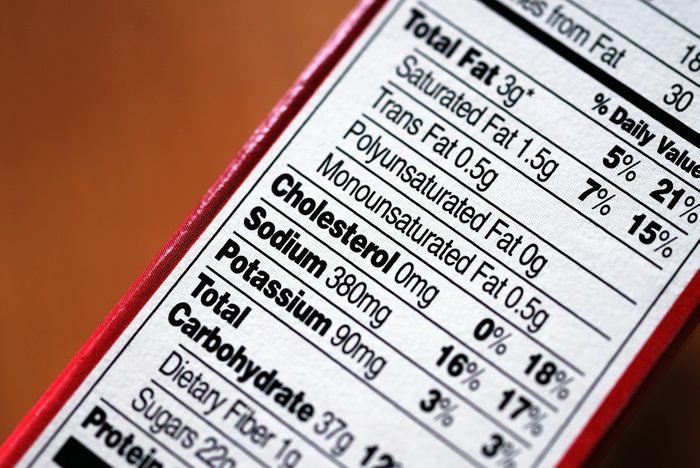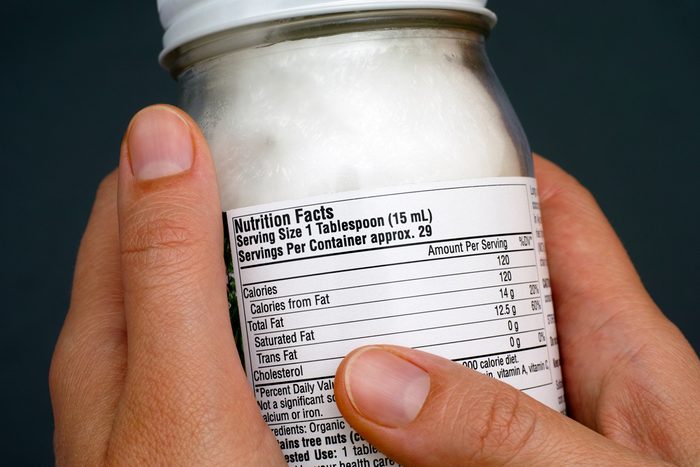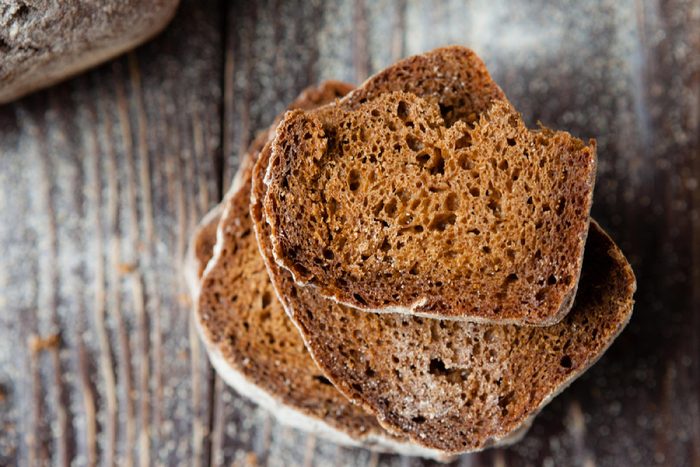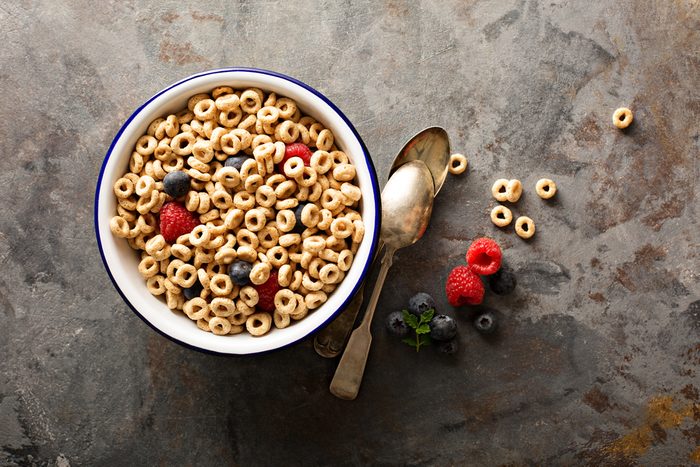When “healthy” isn’t healthy
You probably know this, but food manufacturers don’t always have your best interests in mind when they’re selling you stuff. That’s why they pack sugar into ketchup and salad dressing, salt into soups, and extra chemicals into nearly everything. Arm yourself with these tips the next time you head out for a shop, and you can sidestep the worst foods.

Look for a short ingredient list
When you find a packaged food in the supermarket with a long list of ingredients on the label, just set it back on the shelf and look for a simpler version of the food. (We’re talking here about the “Ingredients” part of the label. Nutrition Facts is another part; more about that later.) The truth is, many of those ingredients are various kinds of sugars and chemical additives, and they’re there to “enhance” the looks, taste, or shelf-life of the food—not your health. While most of these additives aren’t explicitly harmful (although that’s an open question for some of those substances), they also aren’t good for you, either. So check the list of ingredients every time, recommends Marion Nestle, PhD, the Paulette Goddard Professor of Nutrition, Food Studies, and Public Health, Emerita, at New York University and author of Unsavory Truth: How Food Companies Skew the Science of What We Eat. Nestle says that a shorter ingredient list equals fewer added sweeteners and preservatives. These are the things that frustrate every grocery store employee.

Think twice about “no cholesterol” claims
The natural fat cholesterol occurs only in animal products (meat, fish, eggs, milk, and butter, for instance). So why do some plant-derived products claim in large letters that they contain no cholesterol? Because the food companies know that people care about their cholesterol levels, and they know that most people probably have forgotten or never knew that plants don’t contain any. Some of the offenders are cereal, bread, cookies, salad dressings, and, especially, oils and margarine. Oils are obviously fats, so the makers think you’ll be reassured to see that there’s no cholesterol in the corn oil, safflower oil, or olive oil. Next time you see the claim, just say to yourself, “Duh! It’s a plant product! Of course it doesn’t contain cholesterol.”

Learn what “organic” really means
There’s considerable confusion about the use of the word “organic” on food labels, so here’s some guidance: The organic label is earned through a certification process. “The term ‘organic’ is defined by the USDA (United States Department of Agriculture) as a food or food product that hasn’t been produced using antibiotics, growth hormones, pesticides, petroleum-based fertilizers, or bioengineering,” says Patricia Bannan. RDN, author of Eat Right When Time is Tight. “If a food is labeled as ‘organic’ it must adhere to the standards set by the USDA, which includes a lengthy application, thorough record-keeping, and annual inspections.”
• For organic fruits and vegetables, USDA rules—and virtually identical regulations in Canada—say that they must be grown without any of these things: genetically modified seeds, fertilizers made from chemicals or sewage sludge, chemical pesticides or herbicides, and irradiation. Growers are also required to keep records and present them upon demand by accredited inspectors. Foods may also be labeled “100 percent organic,” “organic” (95 to 99 percent organic), “made with organic ingredients” (74 to 94 percent organic), or, for organic content of lesser amount, the specific organic ingredients may be listed.
• On meat, the organic seal means the animals may be fed only certified organic feed and no by-products of other animals. The animals can’t be given hormones or antibiotics. They must be allowed access to the outdoors and treated humanely.
All organic farms must keep records and be inspected by accredited inspectors. There isn’t enough organic food being produced to meet the demand for it, but its availability is increasing all the time. Many supermarkets now carry some organic food, and there is at least one chain (Whole Foods Market) that sells mostly organic. In addition, farmers’ markets, health food stores, and individual farms are good sources of organic food. Nutritionists always do these 14 things at the grocery store, so you should too.

Be suspicious of “natural” labels
If you feel like the food labels “natural” and “organic” are pretty much interchangeable, well that’s exactly what food companies want you to think. But here’s the truth: Use of “natural” on labels is a much more loosey-goosey affair than use of the term “organic.” “Unlike ‘organic,’ the term ‘natural’ is not defined or regulated by the USDA, and does not have any set standards or requirements,” says Bannan. “A food labeled as ‘natural’ does not imply it is made with organic ingredients, or that the quality of its ingredients are better quality or more nutritious.”
Although there’s no single set of requirements for products claiming to be natural, such labels are still supposed to be accurate. If, for example, meat is claimed to be natural because the animal was not fed antibiotics or hormones, the label should say that and it should be true. Farmers or food companies that use the “natural” label are not subject to inspections as a condition of using the label. You just have to take their word for it. These are the unhealthiest foods at your supermarket.

Be wary of the serving size
Many “Nutrition Facts” labels are designed to make you think you’re getting fewer calories than you really are. For example, labels list the nutrients on a per-serving basis. But be sure to check the “serving size” and “servings per container” lines. The candy bar that most people would eat all by themselves in a single sitting may say that it contains two servings. If you saw “100 calories” on the label, you must make a mental adjustment—you’re actually eating two servings, so you’re getting 200 calories.

Use a pocket calculator to compare items
A calculator is the best tool for helping you figure out what the food industry doesn’t want you to know—the actual value of the nutrients in the food you’re buying. For example, say you’re trying to find out which breakfast cereal is more nutritious, General Mills’ MultiGrain Cheerios or Kellogg’s Frosted Mini-Wheats (the original version). The Cheerios serving size is listed as one cup, but the Mini-Wheats serving is 25 biscuits. You can’t really open the box in the store to see how that stacks up against the one cup, so the only way to compare unit to unit is to use grams, which are listed on both packages. The 59-gram Mini-Wheats serving is almost twice the size of the 29-gram Cheerios, so you have to cut in half the nutrients listed on the Mini-Wheats label. Gram for gram, they have similar calories, fiber, carbs, protein, and fat content. These are things that your grocer won’t tell you, but every shopper needs to know.

Get the “whole” story
Marketers know that nutrition-conscious shoppers are interested in whole grains these days, warns the Academy of Nutrition and Dietetics. Don’t be deceived into buying a product that’s labeled “wheat bread,” however. What you really want is “whole wheat” or “whole grain” bread. “Any bread made with wheat-based flour is considered to be wheat bread,” says Bannan. “The difference is that whole wheat flour is made by grinding together the entire wheat grain, made up of the bran, germ, and endosperm. Refined wheat flour grinds only the endosperm part of the grain, eliminating the fiber-rich bran, and micronutrient-rich germ.” Look for bread that lists “whole wheat” or “whole grain” as the first ingredient.

Don’t confuse cereal hype with facts
If you want a healthy breakfast cereal—not just one that just claims to be—ignore the large-type claims on the package and go right to the labels. Look for a brief list of ingredients with ideally a whole grain as the first ingredient, advises Nestle. Sugar should be near the bottom (or absent altogether—you can always add sugar yourself if necessary.) Then look at the per-serving nutrients on the nutrition label. Look for a cereal with a lot of fiber in each serving. Highly sweetened cereals, when fed regularly to young children, condition their taste for sugar at an early age, forming habits that are hard to break. Nestle says that most breakfast cereals are now processed and sugared to such a degree that “they might as well be cookies—low-fat cookies.” These are 50 of the healthiest foods you can buy at the supermarket.

Don’t get soaked for watery foods
Water is the magic ingredient in prepared foods, and if it’s first on the list of ingredients, that’s a clue that there’s a long list of additives to follow to give that water some taste and texture. You might not be surprised to see water at the top of the list of ingredients in soups. After all, soup does take a lot of water. It’s more surprising to find it so prominent in SpaghettiOs. Many salad dressings contain more water than anything else, and since oil and water don’t mix, it takes a bunch of additives to hold everything together. Water is cheap, so the food industry likes it.

Scan the can for MSG
MSG (monosodium glutamate) is a synthetic version of the flavor known as umami (the taste was named by a Japanese scientist). The flavor occurs naturally in some foods, including Parmesan cheese, soy sauce, and mushrooms, and it’s a prominent part of Asian cooking. MSG went out of favor when it became associated with headaches and other unpleasant symptoms. Now many Asian restaurants proudly advertise “No MSG” on their menus, but the food industry still sneaks it in as a flavor enhancer. How to find it? Check out the ingredient list on the labels of prepared foods—on soups, for example. Keep reading, because it’s pretty far down on a long list (although if there is no MSG, that’s usually prominently mentioned at the top).
MSG is sometimes listed under its own name but often under other names, among them “hydrolyzed soy protein, autolyzed yeast, and sodium caseinate, but these are not interchangeable names for MSG,” says Bannan. “Per the Food and Drug Administration (FDA), packaged foods containing added MSG must list ‘monosodium glutamate’ on the ingredient panel. However, MSG occurs in ingredients such as yeast extract and soy extracts, as well as in tomatoes and cheeses. While the FDA requires that these products be listed on the ingredient panel, the agency does not require the label to specify that they contain MSG or glutamate.”
The latest research, however, suggests that there are benefits of MSG if individuals don’t have side effects from it. According to a study in Neuropsychopharmacology, for example, researchers evaluated changes in the brains of women after they consumed chicken broth with or without MSG. They found that added MSG lit up areas of the brain connected to satisfaction and better eating control.
Next, read about the unhealthiest foods you can buy at the supermarket.
